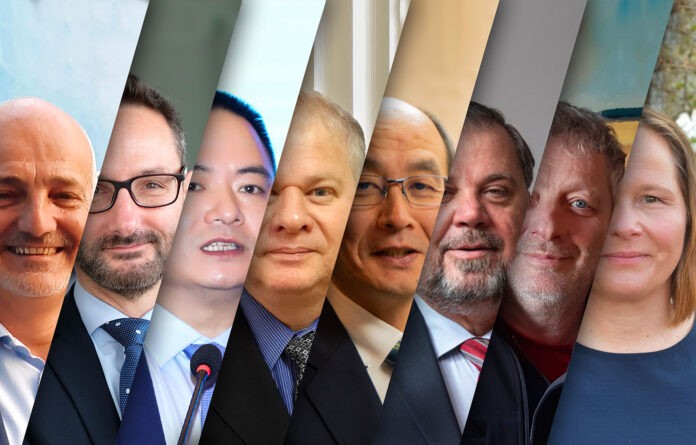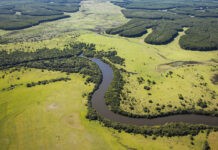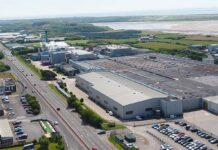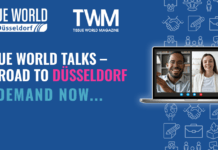
In twenty years tissue machine technology has reduced energy consumption by half, and water consumption by up to 80%. Today, the level of innovation is as strong as ever driven by traditional best practice and accelerated by the challenges of the pandemic and rising costs. Digitalisation of production is evolving day-by-day, taking the industry towards its ultimate goal. Entire plants have now been started up remotely. Here, leading company personnel explain their extensive strategies for machinery launches, energy sourcing and storage, cost controls, and cogeneration.
TWM/1: What changes have you seen in terms of digitalisation over the past year?
Valter Canelli, Sales Director, A.Celli Paper: “Data is amongst the strategic assets of our era and, if managed so as to exploit their full potential, they help guide business decisions and strategies. Moreover, the new logic dictated by the pandemic in progress has even accelerated this process. It is therefore essential to implement solutions that allow you to manage this precious information asset.
“In 2016, the A.Celli Group established its first department entirely dedicated to the development of innovative solutions for the analysis and management of the data of its machines. The business unit – Extreme Automation – is a start-up specialised in Big Data Analysis, IT infrastructures, Machine Learning and Artificial Intelligence, offering cutting-edge Industry 4.0 solutions capable of bringing significant benefits to tissue paper production plants, such as example:
• Improvement of efficiency and energy saving opportunities
• Product optimisation and relative standardisation
• Reduction in the number of out-of-specification products
• Reduction of raw material waste
• Reduction of downtimes
• Implementation of predictive maintenance processes
• Constant software updating.
“Furthermore, we must add that digital technologies have allowed us to be ever closer to the needs of our customers, even while respecting social distancing requirements. In particular, I refer to the opportunity of being able to guarantee the management of the production line remotely, both in the erection and start-up phases, and in the assistance and technical support.”
Stefano Marenco, Director Tissue R&D and PrimeLineTIAC (pilot plant), Andritz: “During the last couple of years, digitalisation has continued to change the way of working in many ways. Especially with the global pandemic, this has accelerated the digital transformation and significantly impacted how we were used to operating and organising our daily business. With our digital solutions, we were able to rapidly adapt and compensate for many associated challenges that came along with the global restrictions. For instance, our already available remote offerings allowed us to proceed with projects where a personal presence of engineers was not possible to the same extent anymore. This way we successfully started up entire plants remotely with very limited resources onsite and could therefore maintain the same level of professionalism and delivered quality to our customers. Since digitalisation still offers incredible potential to engage with colleagues and customers around the globe, most companies will continue to further develop these technologies and seize new opportunities to gain an edge over competitors.”
Qingyao Li, Deputy General Manager, Baosuo Group Baotuo Paper Equipment Co.: “In the past year, while the epidemic continued, most manufacturers such as Baotuo paper machine insisted on doing business through digital and networked technology. As there was reduce on-site service personnel, we were able to use the internet to maintain and upgrade equipment.
“The digital response more accurately shows the energy consumption of each part. It is more conducive to the improvement of Baotuo’s paper machine technology and the stability of the paper machine.
“Using digital upgrading technology, Baotuo achieved a breakthrough in 1,800m/min Crescent paper machine in 2021, which is more energy-saving, more efficient and more stable than traditional paper machines.”
William Rodrigues dos Santos, General Manager, Hergen: “The Covid-19 pandemic spread and speeded up the development of information exchange technologies. In this context we can list the home office, online schooling, conferences, webinars and mainly Industry 4.0. Hergen, along with its automation partners, is implementing more and more of these concepts on new projects because we understand that once you have tools to collect more process data, the mill and our team can perform a more accurate analysis and a more precise corrective action.
“Additionally, with the proper automation level it is also possible to use remote operation and parameters to check-up, helping the mill team on troubleshooting and process optimisation.
“During the pandemic’s first wave this remote assistance, along with a dedicated and skilful local team, made it possible for us to perform a tissue plant start-up in Poland. That would have been totally impossible just a few years ago.
“We understand that in some cases local intervention is needed, however digitalisation is here to help us all on a wide range of fields and is up to us to get the best out of it for our and our customers’ benefit.”
Shinji Goda, Director and General Manager of Engineering, Kawanoe Zoki: “The use of the remote maintenance service K-Connect (Kawanoe e-Connect) and web conferencing has become very common in Japan. This is because many of our customers are dealing with household paper, and they are very wary of face-to-face meetings because they are concerned about the impact of the spread of Covid-19 on their production. Not all of our customers are ready for digital technology, and we expect that technology and services in this area will definitely grow in the future.”
Alberto Tomelleri, Sales & Marketing Director, Recard: “Data collection – remote service.”
Luca Ghelli, R&D Director, Toscotec: “Digitalisation has been well acquired as a concept by paper producers and distributors who realise the advantages of an improved process control, which translates into higher plant efficiency, better and faster communications with suppliers and customers, and more flexible internal procedures. Digitalisation helps us to better understand, describe and predict physical phenomena, also highlighting process connections that were not completely evident with simpler analysis or surveys, and allowing us to keep processes under control with more accuracy.
“Being aware of this, Toscotec developed its digitalisation processes to control the overall plant. The pandemic pushed us to use digital communication, which forced people to learn how to use this new way of exchanging information efficiently and organise all databases accordingly to be clear, complete, and accessible.
“In general terms, digitalisation encompasses all aspects of our work: from communication to product and operation design. In relation to our products and associated processes, Voith has achieved its Papermaking 4.0 portfolio results in terms of advanced process control, data visualisation and analysis. Together with Toscotec’s know-how and competence for tissue, they applied that experience to tissue products and processes.”
Jenny Lahti-Samuelsson, Vice President Tissue Global Technology, Pap Tissue Mills Business Unit, Valmet: “Digital development has taken off in a manner and pace that was difficult to anticipate. Even before the pandemic we were strongly developing our remote services and digital tools and they really came into use when the virus struck. It helped us to take full benefit of the digital tools and we have further developed our way to operate in order to serve and support our customers. A concrete example is that we have carried out machine check-outs and start-ups at customer sites with our experts supporting remotely. This change is consistent and will also be a good complement to on-site services in the future.
“These are tools that can be good complements when it gets harder to find appropriate competence, especially as organisations are getting slimmer and tighter. Digitalisation of products is evolving day-by-day taking us towards more autonomous mills. The pace will be set by the actual needs from the industry and of course payoff of solutions.”
TWM/2: What machinery launches and tissue machine technical developments were key for you in 2021 and why was this?
Canelli: “Research and development is not only a precious activity for A.Celli, but it is the essential strategy for continuous growth and a forward-looking vision. Continuous improvement allows us to gain and maintain a competitive advantage in an increasingly competitive global tissue and paper industry. During 2021, thanks to the continuous development and improvement of our Yankee Dryers, in A.Celli we have evolved our Yankee Dryer conceiving the innovative iDEAL Evo-Lock. Our new solution is built with all the A.Celli technologies already known and appreciated, including the shell forged from a single steel ingot, with the novelty of a unique and highly innovative head-to-shell connection system, which does not require the use of structural welds or bolts and allows to minimise the costs related to inspection operations and is equipped with technological solutions never seen before on a Yankee Dryer.”
Marenco: “One of our major machinery launches was the upgrade of the Andritz well proven PrimeLineTM machines to 2,200m/min, both the single-wide 2.85m PrimeLineTM S 2200 as well as the double-wide machine PrimeLineTM W 2200. They are among the fastest tissue machines worldwide, with the target to boost production capacity, especially for lower basis weights. They can be equipped with resource-saving components like the PrimePress XT Evo shoe press, the PrimeDry Stell Yankee and the PrimeDry Hood ST (steam-heated).
“These machines also feature Metris – Andritz digital solutions – which enable remote assistance during commissioning and start-up as well as improved operation.
“Beside this machinery launch, technical developments have been done in the field of reducing CO2 footprint, as well as in the field of machine safety and efficiency increase. As an example I would like to point out the fully cantilever shoe press concept, which enables a faster change of the felt and shoe press belt, and at the same time is increasing the safety of this procedure in a high degree.
“During the past few years, demands for safety have become more and more important in the market. For the machinery supplier, a fundamental understanding of the machine directives and environmental protection standards are essential – Andritz has done lots of efforts to develop and include smart solutions for safe operation in our tissue machine concepts.”
Li: “With the in-depth promotion of the use of household paper, reducing costs and increasing the added-value of paper products is another new breakthrough in the development of papermaking technology in recent years.
“Baotuo paper machine has always insisted on low energy consumption, low production cost, reducing the use of plant fibres and protecting the environment, and has made great progress in TAD technology.
“The advancement of TAD technology brings huge business opportunities for the development of papermaking technology.”
Rodrigues dos Santos: “Our latest tissue machines were developed with a total focus on the lowest media consumption possible. We realised that in most cases (mainly in developing countries) that the fastest machines are not the most profitable ones. The reasons were due to gas and/or electrical energy costs and a poor analysis of the energy matrix of the country or even region where a tissue machine is installed, resulting in a machine that is not the best for this particular application.
“For each project we analyse the customer energy matrix and define the YD size and hood parameters that result on the best cost-effective solution.
“For instance, in Brazil biomass is fairly cheap compared to other combustibles for boilers, so it is highly advisable to use a Yankee Dryer as large as possible to have a small contribution from the hood resulting on less gas and electrical energy consumption, thus a more profitable product. With that in mind we updated our intermediate Tissue Machine model with some features from the fastest ones, i.e., we gave to the intermediate model all the stability features of a 2,200m/min machine combined with the cost of a 1,800m/min model. This results in a machine with an impressive low media consumption, a flexible concept, which enables future updates in order to reduce the initial investment. That presents a competitive cost which is an important feature in such a competitive market.”
Goda: “Air towels had been used in many toilets in public facilities and large commercial facilities in Japan, but their use was stopped as it could lead to the spread of Covid-19. Kawanoe has developed a new technology – Head Box – and installed a number of new towel machines to enable the production of bulky and highly absorbent towel paper.”
Tomelleri: “We are always focused on satisfying our client’s needs and supplying them with a global solution. Our capability to design, manage, manufacture, ship, install and start-up turnkey projects is our winning point. The key in the past few years was to be flexible and go beyond the standards in providing turnkey systems. For instance, by also supplying effluent treatment and freshwater treatments, or by supplying special machines such as winder duotype which are able to wind tissue paper and MG paper in the same machine, as we have done recently. The ability to include a cogeneration with a gas turbine in one of our projects was also quite important to win the order.”
Ghelli: “In 2021, Toscotec’s R&D team did extensive work on TAD technology and upgraded our original design with new ideas and concepts that led to a performance increase if compared with current performances of TAD machines worldwide.
“We also acquired several orders of double-width, high speed tissue machines where we implemented new solutions aimed to reduce energy demand, increase machine efficiency, and improve paper properties.
“In the tissue machine rebuilds market, we also received numerous orders of key components, including Steel Yankee dryers, Yankee hoods, headboxes, and shoe presses to be installed on existing plants to boost the performance and efficiency of existing machines. These projects gave us the opportunity to strengthen Toscotec’s position as supplier of high- tech key components.”
Lahti-Samuelsson: “In recent years we have launched several machine concepts within the hybrid segment that allows our customers to produce high end tissue products with lower environmental footprint. The demand for better tissue quality in combination with sustainable results have increased the interest and sales of the hybrid machine concepts.”
TWM/3: What progress have you made in 2021 in terms of energy reductions and sustainability on your TM projects?
Canelli: “A.Celli has always been committed to sustainability and all our solutions are designed and manufactured with this objective in mind. To reduce the consumption related to the drying phase, for example, in addition to the conventional suction press roll A.Celli now offers various configurations like double press, specially designed shoe press for Tissue applications, last but not least, our new X-ROLL solution. This latest solution is designed to combine the quality obtainable with the traditional single press configuration with an energy saving of over 16% in the drying phase, thanks to a 4% increase in the degree of dryness of the paper exiting the pressing process.”
Marenco: “The projects focused on mechanical dewatering brought real improvements on our shoe press features collecting good results in new sales. Impressive results were also collected with our PrimeLineTEX at the pilot machine where top soft premium products were produced with very low energy consumption confirming the hybrid technologies as a valid replacement to TAD when sustainability and energy reduction are needed.
“Also in the thermal drying efficiency field, the Andritz Tissue Group successfully started up new steam recovery plants PrimeDry YES to produce steam from exhaust hot air of the Yankee hoods and we received additional orders for the upcoming year. With simple modifications of the existent plant, PrimeDry YES can easily provide 10-15% energy savings in the drying energy costs.
“Among more efficient products designing, intensive work was also done in supporting our customers in upgrading their assets. The Andritz service team worked a lot in energy assessment of plants in operation and assisted in planning to replace low efficiency equipment with new performing solutions. A leap in CO2 emissions reduction and efficiency improvement was then possible with state-of-the-art solutions. We appreciated that a lot of paper mills offer huge potentials in energy improvements with focused rebuilds. Especially in a moment where energy costs are to dramatically increase, the return of the investments could be very fast and also be very profitable.
“New technology developments do help the industry to improve, but maintenance still remains a key factor in ensuring low energy costs and good efficiency of the systems. Andritz technology offers very standard solutions or very tailor-made products to help customers in upgrading their plants.”
Li: “Baotuo has always insisted on using less fibre raw materials and lower carbon emissions to achieve the production of toilet paper. Reducing the moisture before the paper is loaded into the cylinder, improving the air pressure system of the idler to a hydraulic system, and removing more moisture with a stable line pressure, etc, are all energy-saving and production-enhancing goals to achieve sustainable development.
“At present, Baotuo paper machine leads the industry in unit energy consumption and has been recognised by the industry.”
Rodrigues dos Santos: “We are about to start-up a high-speed tissue machine with a new drying concept that uses on the hood wet end, hot air (over 300°C) from the biomass boiler’s thermal system, and on the hood dry end a simple extraction hood with internal heating to avoid condensation. This hood concept combined with a large Yankee Dryer and the hood heat recovery system enables a working speed of over 1,800m/min with low media consumption, resulting in a competitive final product cost. This new machine will also feature our stock injector which optimises the thick stock and white water mixing on the machine’s wet end, and with that we are able to improve paper formation and a stable MD and CD profiles. This enables a steadier machine operation that takes machine performance to an impressive level.”
Goda: “In Japan, about 60% of toilet paper is produced from recycled paper. In terms of quality, such as feel and softness, Japan’s recycled paper products are said to be of extremely high-quality worldwide. We believe that recycled paper products are sustainable products that truly embody resource conservation. Japan’s recycled paper collection system and stock preparation technology make it possible to recycle various types and qualities of recycled paper.
“In response to the trend toward the use of difficult-to-process paper due to the reduction of waste paper generated by digitisation, we will continue to make full use of our papermaking technologies to produce high-quality products and contribute to the environment.”
Tomelleri: “Saving energy and resources continues to be the main objective of the manufacturers of tissue machines. We have perfected the process in the peripheral areas of the machine – such as the approach flow system – by proposing, in addition to the elimination of the mix chest replaced by a static mixer, to also use the approach screen in medium consistency, thus ensuring a significant decrease in specific power to the fan pump. On the other hand, the thermal energy savings (about 30%) is substantial when using our not conventional stand alone, high load, double felted shoe press, which not being applied against the Yankee Dryer allows, in addition to extraordinary web dryness, also the maximum yield of the Yankee, not requiring increased thickness of the Yankee shell like conventional shoe presses requires. We have also to mention that with the natural gas level price raised in the last months alternative fuels have to be considered like Syngas.”
Ghelli: “Toscotec implemented several solutions both on its tissue machines and on the design of complete plants associated with the reuse of exhaust energy within the process. Improvements were made in the air system of TAD machines or traditional technology, and in the recovery of energy from the complete process including stock preparation and approach system.
“We upgraded the design of Toscotec’s press rolls to achieve maximum dewatering before the drying section without affecting paper quality, which reduces the energy-intensive drying needs at the end of the process. “Toscotec also developed new processes in ‘mechanically’ removing water from the paper without using heat, in order to reduce the overall energy demand of the tissue machine.
“Digitalisation and process optimisation provided a value added by delivering faster, more precise responses to process variation and quickly achieving the best running conditions for a specific production. This led to an increase in the efficiency of the complete plant. All these activities allow us to offer production plants with lower consumption figures because of the improved technology and higher efficiency.
“During the past year we also started multiple projects aimed to reduce emissions and CO2 footprint by replacing traditional fossil fuels or gas.”
Lahti-Samuelsson: “Fluctuation in pulp and energy prices have been tough challenges for tissue producers, but maybe energy consumption is the most critical challenge. It is especially tough for those who has an older machine asset where energy efficiency is low and thus faces a situation where it is hard to absorb the price increases. Here we see products like the Advantage ViscoNip press and ReDry as important and impactful tools that can help customers in lowering the energy consumption.
“Also, when it comes to fibre sources and their environmental impact we are now putting more emphasis into usage of alternative fibers to ensure high tissue quality and operational performance. In parallel we are also looking for new and refined ways of using MFC (micro fibrillated cellulose) in order to enhance paper quality, etc.”
TWM/4: What technical demands for paper machine lines are you seeing from the market, and how are you responding? Where will your R&D be focused in 2022?
Canelli: “Nowadays every commercial demand coming from our customers needs to be deeply investigated in terms of energy consumption.
“This is the most delicate point towards which we see the attention of the market.
“The paper industry absorbs around 10% of the energy produced in the world, and is second only to that of steel. Much of the thermal energy is transferred to the machine in the form of steam, mainly for multi-cylinder continuous machines, or high temperature gas, in the case of tissue paper plants. A.Celli Paper’s focus for 2022 is to continue investing in the development of solutions aimed at energy saving, with particular attention to the cogeneration concept, intended as implementation of an auxiliary plant capable of simultaneously and virtuously generating the two forms of energy necessary for the paper mill, eliminating the need on the one hand to draw electricity from the grid and on the other hand to burn gas to produce steam in a boiler.
“A further topic to be explored will be the one linked to the use of alternative energies compared to the ones currently in common use in tissue and paper production plants.”
Marenco: “Energy and sustainability will be a continuous key driver of our research also for 2022. The energy price increases in the last months of 2021 made European tissue producers push further their interest for new low energy consumption concepts and applications. In line with Andritz’s “WE CARE” Environmental Social Governance programme, R&D and technology are reviewing the action plan for prioritising the development of new ideas.
“SDG (Sustainable Development Goal) 12 is in Andritz’s eyeline and a related Life Cycle Thinking (LCT) concept in under review. We know that sustainability is not only products, but an attitude in the whole life cycle that needs to be assessed in its whole process. Deeper discussions with our customers need to be addressed for a more integrated vision of the tissue process.
“R&D will be focused on renewable energy use in tissue. A leap forward in the renewable energy storage is expected to happen very soon and tissue industry needs to invest in using this type of energy in the production processes. Drying processes will be greatly affected by new concepts and new needs. This represents the next challenge in tissue for PrimeLine Tissue Technology.”
Li: “Previously, most of the customers’ requirements for paper machines were high efficiency and low energy consumption. However, with the increasing concentration of the industry, large-capacity, low-energy-consumption, and high-efficiency equipment will increasingly become the needs of mainstream customers. The future direction of Baotuo paper machine will focus on continuous research and development and the promotion of equipment with large production capacity, low energy consumption and full intelligence.”
Rodrigues dos Santos: “The protection, maintenance and improvement of the environment has been a global concern for many years, and this will intensify in the years to come. For the paper industry – not only the papermakers but also the machinery builders – we must share the efforts to reach these goals.
“Based on that our R&D team is focusing on our shoe press design and targeting the reduction of drying energy requirements, and on the rational use of water discussing with machine fabric suppliers to minimise the use of fresh water on fabric conditioning, without affecting its lifespan and performance.
“We are offering to the market stainless steel rolls which waive the use of rubber cover contributing on the carbon footprint on paper business. We are also applying on our machines the most modern burners available which optimise the gas consumption and feature lower Ox and NOx emissions.”
Goda: “We believe that equipment that can produce products with higher added value than conventional products and flexible equipment that can produce a wider variety of products will be required.
“For paper machines, we will focus on the development of machines that can handle a wide range of basis weight. We are also a manufacturer of both paper machines and converting machines.
“At the same time, we are working on the development of a converting machine that can produce paper packaging products as an alternative to film, while enhancing product value and taking environmental issues into consideration.
“This year, we will start operating a pilot converting machine to develop products together with our customers. By combining the technologies of paper machines and converting machines, we will be able to meet the demands of the market.”
Tomelleri: “Saving energy and resources will again be the focus for 2022 and in future years. Shoe press and cogeneration with gas turbine and recovery boiler are the areas where the saving could be more significant. On one hand, with the shoe press increasing the dryness it is possible to minimise the water to be evaporated from the tissue web, and on the other, with a combination of gas turbine and recovery boiler we are recovering as much as possible the thermal energy introduced in the process.”
Ghelli: “The market is urgently requesting the implementation of revolutionary paper making technologies with limited energy demand. Toscotec is working on improving existing technologies and developing some disruptive ideas that will bring down current energy demands by a huge amount. Important research efforts have been allocated to these areas.
“A new and more all-encompassing approach is required on the part of manufacturers in that the design of a production plant is no longer limited to the tissue making line but rather it constitutes a complete facility that produces the energy it needs, or outsources energy generated in compliance with new green regulations. Toscotec is well prepared to guide producers to implement this new all-encompassing approach.”
Lahti-Samuelsson: “The interest in carbon neutrality and fossil free production is increasing rapidly. One way to achieve that is to ensure efficient tissue making processes. This has been high on our agenda for decades and will continue to be. Even though we are proud to say we have had good progress, we are constantly striving to improve resource efficiency and reduce the environmental impact of our equipment.
“There is a huge difference in energy and water usage when comparing a tissue machine designed in the 90s to a modern machine. Even though the 90s does not seem that long ago, a modern machine consumes half of the energy compared to a twenty-year-old machine, and water consumption has dropped by as much as 80%. Good achievements but we cannot by any means relax; now there we need to take the next steps to further improve the environmental footprints. Developments on tissue machines have come a long way in a short time. At the same time, we are noticing a demand for higher efficiency and production capacity combined with fibre, energy and water savings. To achieve that we need to pay close attention to the runnability.
“Good runnability is a crucial part of our R&D work. Besides optimisation and improvements in machine and process design, our digital solutions through Valmet industrial internet are enablers to meet the need of improving operational efficiency.
“To achieve a fossil free operation is thus essential both for us and for our customers. Valmet’s climate neutrality programme focuses on enabling fossil free production and operations for our customers but is also targeting to reduce CO2 emissions at our suppliers and our own operations.”
TWM/5: Pre-Pandemic, the global tissue market was seeing steady consumption growth. What opportunities and challenges do you forecast for the global tissue market in 2022 and 2023?
Canelli: “The Corona pandemic caused contradictory developments in the tissue market and revolutionised the logic we were used to knowing.
“One of the key questions of any future prediction is related to how and how quickly economies will recover from the influence of the pandemic and factors of production will return to align with standard levels and standards and trends (with particular focus on the aspect linked to energy consumption and the cost of raw materials).
“In the meantime, all the players in the sector will look for ways to improve their production, to adopt sustainability requirements, to identify best practices by digitising the industrial assets to support the ongoing transition. Ultimately, we expect enormous opportunities in the field of digital solutions and data integration between processes and systems.”
Marenco: “The Corona pandemic caused turbulence and changes during the past few years. From panic-buying at the beginning of the outbreak, to a decrease in the AfH market due to lockdowns and travel restrictions, which was partly almost compensated for by shifting some portion to the consumer market and increasing consumption in the medical care industry.
“Then, the situation got more and more stable and less restrictive, caused by a higher portion of vaccinations throughout the population and the reluctance of many governments to prescribe restrictions where possible. For 2022 and 2023 we expect a further increase in tissue consumption, especially in regions where the specific consumption is around or below the world average – in particular, those in China and the rest of Asia in line with increasing living standards as well as higher sensitivity to hygiene behaviour in general as a result of the learnings during the Pandemic. Also in South America, where we expect good growth rates in the coming years.
“Increasing pulp and energy prices are certainly a big challenge for the tissue producer and in addition to that the more and more stringent requirements of CO2 footprint reduction in line with the use of green solutions. This will trigger more optimisation of existing machineries and systems and will make new investments more restrictive, as we see already for example in China.
“And for the machine supplier? Andritz is prepared for these challenges and has started three initiatives, the “WE CARE” Environmental Social Governance programme, “CircleToZero” with the goal of achieving zero emissions and zero waste and Andritz has also introduced various “tissue solutions to reduce CO2 footprint”. Supplying sustainable solutions to the tissue industry will be one of the major challenges but also opportunity in the coming years.”
Li: “Affected by the global epidemic and fluctuations in pulp prices, some small papermaking enterprises have stopped production or even withdrawn from the market, and have been replaced by medium and large-scale powerful enterprises. Under the epidemic, as public awareness of hygiene has increased and the demand for toilet paper and hygiene products continues to grow, the trend of industrial concentration will become more obvious. Industrial concentration will bring about technological innovation and progress. It is an opportunity and also a challenge. Baotuo will keep abreast of market changes, adhere to technology research and development and technological innovation, and strive to remain invincible in market changes.”
Rodrigues dos Santos: “Regarding tissue consumption, we believe that once the restrictions are lifted and life is back to normal the parameters are supposed to be back to pre-pandemic levels. However, it is quite difficult to point out when this is going to happen. It is visible that in countries where restrictions have been reduced the consumption started to grow again. We must be prepared to give to the market a quick answer when this demand increase occurs.
“Since the beginning of the pandemic we have seen a constant increase in pulp prices, and this fact allied with the reduction of demand has restrained new investments in both new machines and machine rebuilds. We believe that once the market stabilises all these projects will move on and based on that we have been preparing our workshop and engineering with cutting edge machines and software to enable us to have the agility of response required by the market.
“We believe that the markets that will have a faster recovery are those where vaccination was more efficient and disseminated. Regarding new markets we believe that South America and mainly North of Africa are the regions that may feature the highest growth in terms of tissue consumption.”
Goda: “I believe that the tissue market will continue to grow steadily on a global scale. In particular, with the rise in hygiene awareness due to the Covid-19, there will be more variations and more choices for household products. I hope that the value of paper as a household product will be re-evaluated and its use as a sustainable material will expand.”
Tomelleri: “The Covid pandemic has had a big impact in the market with some crazy situations. Because of all the closures of restaurants and such, the AfH market was badly impacted but is now recovering and volumes and values are increasing. We also see a continuous growing in several areas of the world as Asia and Africa and also South America are showing good opportunities for business. In the evolved markets, the growth of private labels will proceed sustained by the market distribution chains, even despite an erosion of margins due to the strong competition. At the same time major challenges in the near future will be energy and transport and this two areas are heavily impacted in the tissue market, with costs increasing in the already critical situation due to the pulp price fluctuation.”
Ghelli: “The quality gap between AfH and At-Home products has constantly been shrinking for numerous years, and the pandemic speeded up this trend. Technological advance may close the gap by delivering lower production cost and higher quality of the final product.
“At the same time, emerging markets will probably continue to raise their demand for quality, and this may open new opportunities for technologies which are still mainly developed by European manufacturers. Regarding the impact of cellulose price and availability on the market, the use of diverse, recycled, and recyclable fibres increased and brought a considerable advantage as a new source of raw materials. If the promise of a greener planet is maintained, we believe that sustainability will increasingly become a bonus and it will play a significant role as a driving force for paper producers and machinery manufacturers.”
Lahti-Samuelsson: “We foresee a stable growth in tissue consumption in total. The AfH market will most likely catch up when life is going back to a more normal situation. There have been more investments during the pandemic than we dared to hope for two years ago. We are now also seeing China and Asia taking a step forward towards consumer products with premium quality.
“At the same time there is high pressure from authorities to reduce energy consumption and environmental impact. Valmet’s hybrid concepts are well suited to match these demands in terms of quality, energy and fibre efficiency.
“Longer term, it’s most likely that the hygiene awareness and concern will remain in the consumer’s mind. This will stabilise the need for tissue and towel products on a higher level as well as create opportunities for innovations in this field.”
































